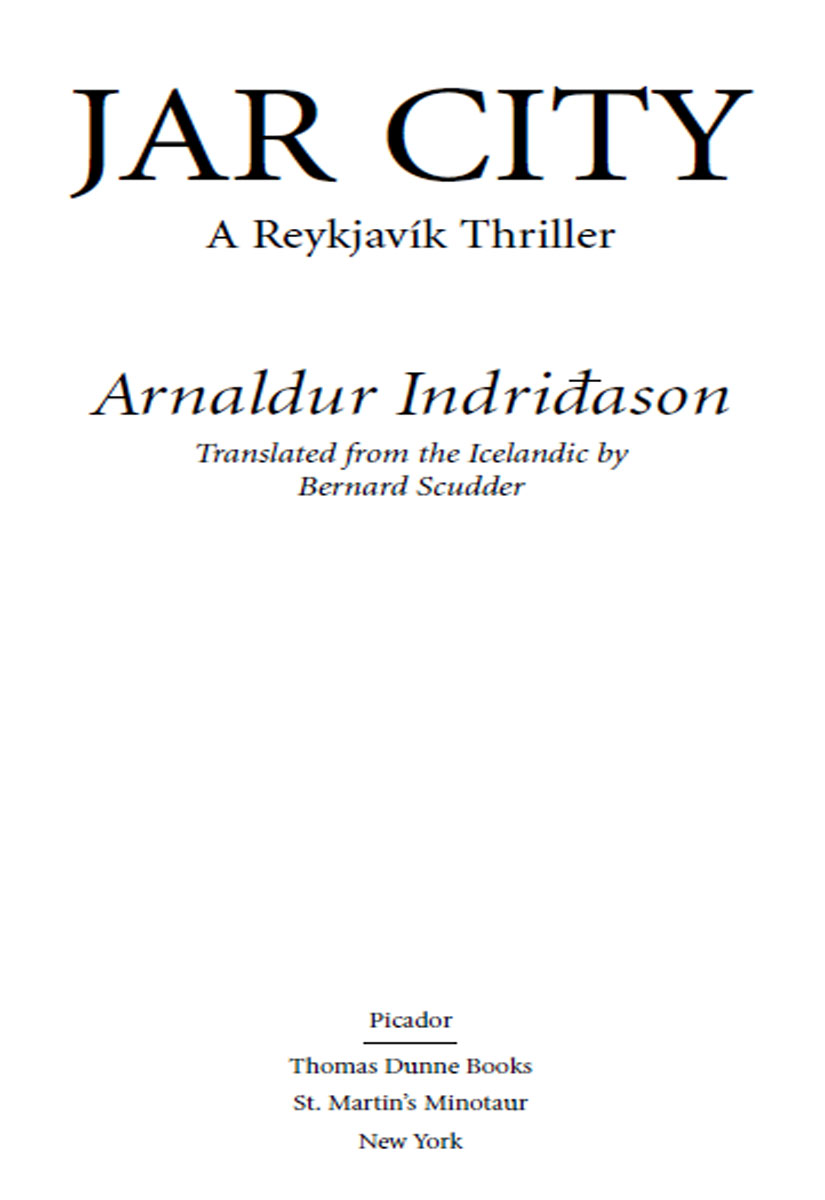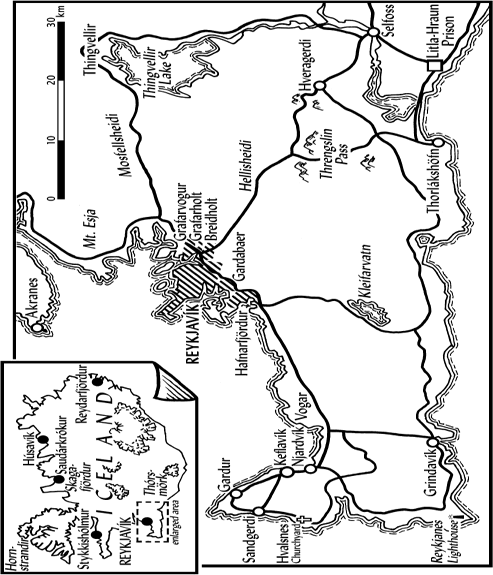Jar City
Authors: Arnaldur Indridason



Photo credit: Einar Falur Ingólfsson
Arnaldur Indri ason was born in 1961. He worked at an Icelandic newspaper, first as a journalist and then for many years as a reviewer. He won the Nordic Crime Novel Award for
ason was born in 1961. He worked at an Icelandic newspaper, first as a journalist and then for many years as a reviewer. He won the Nordic Crime Novel Award for
Jar City
and won again for its sequel,
Silence of the Grave
, which also won the prestigious Gold Dagger Award. He lives in ReykjavÃk, Iceland.
Jar City
“Award-winning Iceland author Indri ason makes a compelling American debut with this first in a series featuring ReykjavÃk police inspector Erlendurâ¦. Quiet, morose, dryly witty, Erlendur makes a fine, complex companionâ¦. Those who enjoy Karin Fossum, Henning Mankell, or Janwillem van de Wetering will welcome this new series.”
ason makes a compelling American debut with this first in a series featuring ReykjavÃk police inspector Erlendurâ¦. Quiet, morose, dryly witty, Erlendur makes a fine, complex companionâ¦. Those who enjoy Karin Fossum, Henning Mankell, or Janwillem van de Wetering will welcome this new series.”
âThe Portsmouth Herald
“A powerful, psychologically acute procedural drama.”
âBooklist
“
Jar City
is classic mystery fiction, both compassionate and thrilling. Indri ason is about to become one of the brightest stars in the genre's dark skies.”
ason is about to become one of the brightest stars in the genre's dark skies.”
âJohn Connolly, author of
Dark Hollow
“There's much to glean about the people of Iceland from this erudite and compelling storyâ¦.
Jar City
taps into the melancholy of Scandinavian perspective and manages to be quite thrilling, too.”
âRocky Mountain News
“This careful, sparsely written book operates at a deeper level than most crime fiction: it conveys the sense of painful inevitability underlying the old stories that medieval Icelanders told through the long winter nights.”
âThe Independent
(London)
“The descriptions of ReykjavÃk and the surrounding areaâ¦are fascinating in their own right, and the plotting is rivetingâ¦. Detective Inspector Erlendur Sveinsson is an intense and introspective protagonist.”
âBookPage
“The author's American debut, winner of the 2002 Nordic Crime Novel Award, is a model puzzle presented with clarity and crisp economy.”
âKirkus Reviews
“An absorbing police procedural dense with psychological pressure. The plot is a twister, the setting unique, and Erlendur's personal life is even bleaker than the Icelandic fall. Erlendur is a cop to watch. And I will.”
âMarshall Browne, author of
The Eye of the Abyss

It's all one great big bloody mire
â
INSPECTOR ERLENDUR SVEINSSON


Icelanders always address each other using first names, since most people have a patronymic rather than a “proper surname”, ending in -
son
for a son and -
dóttir
for a daughter. People are listed by first names even in the telephone directory. Strange as it may sound to the English ear, first names are therefore used throughout the police hierarchy and when police and criminals address one another. Erlendur's full name is
Erlendur Sveinsson
, and his daughter is
Eva Lind Erlendsdóttir
. Matronymics are rare, although Audur is specifically said to be
Kolbrúnardóttir
, “Kolbrún's daughter”. Some families do have traditional surnames, however, either derived directly from or else modelled on Danish, as a result of the colonial rule which lasted until early in the twentieth century.
Briem
is one of these traditional surnames, and as such it does not reveal the gender of the bearer â in the case of
Marion Briem
the ambiguous first name compounds this secondary mystery.
The words were written in pencil on a piece of paper placed on top of the body. Three words, incomprehensible to Erlendur.
It was the body of a man of about 70. He was lying on the floor on his right side, against the sofa in a small sitting room, wearing a blue shirt and fawn corduroy trousers. He wore slippers on his feet. His hair was starting to thin, almost completely grey. It was stained with blood from a large wound on his head. On the floor not far from the body was a big glass ashtray with sharp corners. It too was covered in blood. The coffee table had been overturned.
This was a basement flat in a two-storey house in Nordurmýri. It stood in a small garden enclosed on three sides by a stone wall. The trees had shed their leaves, which carpeted the garden and covered the ground, and the knotty branches stretched up towards the darkness of the sky. Along a gravel drive which led to the garage, ReykjavÃk CID were arriving at the scene. The District Medical Officer was expected, he would sign the death certificate. The body had been reported found about 15 minutes earlier. Erlendur, Detective Inspector with the ReykjavÃk police, was one of the first on the scene. He expected his colleague Sigurdur Ãli any minute.
The October dusk spread over the city and the rain slapped around in the autumn wind. Someone had switched on a lamp which stood on a table in the sitting room and cast a gloomy light on the surroundings. In other respects nothing on the scene had been touched. The forensics team were setting up powerful fluorescent lights on a tripod to illuminate the flat. Erlendur noticed a bookcase and a worn suite of furniture, the overturned coffee table, an old desk in one corner, a carpet on the floor, blood on the carpet. The sitting room opened into the kitchen and another door led from it to the den and on to a small corridor where there were two rooms and a toilet.
The police had been notified by the upstairs neighbour. He had come home that afternoon after collecting his two boys from school and it struck him as strange to see the basement door wide open. He could see inside his neighbour's flat and called out to discover whether he was in. There was no answer. He peered inside the flat and called his name again, but there was no response. They'd been living on the upper floor for several years but did not know the old man in the basement well. The elder son, 9 years old, was not as cautious as his father and quick as a flash he was in the neighbour's sitting room. A moment later the child came back and said there was a dead man in the flat, and he really didn't seem too perturbed by it.
“You watch too many movies,” the boy's father said and cautiously made his way into the flat where he saw his neighbour lying dead on the sitting-room floor.
Erlendur knew the dead man's name. It was on the doorbell. But to avoid the risk of making an idiot of himself he put on some thin rubber gloves and fished the man's wallet out of a jacket hanging on a peg by the front doorway and found a payment card with a photograph on it. The man's name was Holberg, 69 years old. Dead in his home. Presumed murdered.
Erlendur walked around the flat and pondered the simplest questions. That was his job: investigating the obvious. Forensics handled the mysterious. He could see no signs of a break-in, neither on the windows nor the doors. On first impression the man seemed to have let his assailant into the flat himself. The upstairs neighbours had left footprints all over the front hallway and sitting-room carpet when they came in out of the rain and the attacker must have done the same. Unless he took off his shoes by the front door. It looked to Erlendur as if he had been in too much of a rush to have had the chance to take off his shoes.
The forensic team had brought along a vacuum cleaner to collect the tiniest particles and granules from which to produce clues. They searched for fingerprints and mud that did not belong in the house. They looked for something extraneous. Something that had left destruction in its wake.
For all Erlendur could see, the man had shown his visitor no particular hospitality. He hadn't made coffee. The percolator in the kitchen had apparently not been used in the past few hours. There were no signs of tea having been drunk, no cups taken out of the cupboards. Glasses stood untouched where they belonged. The murdered man had been the orderly type. Everything neat and tidy. Perhaps he did not know his assailant well. Perhaps the visitor had attacked him without any preamble, the moment the door opened. Without taking off his shoes.
Can you murder someone in your socks?
Erlendur looked all around and told himself that he really must organise his thoughts better.
In any case, the visitor had been in a hurry. He hadn't bothered to close the door behind him. The attack itself showed signs of haste, as if it had come out of the blue and without warning. There were no signs of a scuffle in the flat. The man had apparently fallen straight to the floor, struck the coffee table and overturned it. On first impression everything else seemed untouched. Erlendur could see no sign that the flat had been robbed. All the cupboards were firmly closed, the drawers too, a fairly new computer and an old stereo where they belonged, the man's jacket on a peg by the front doorway still contained his wallet, in it one 2000-crown note and two payment cards, one debit and the other credit.
It was as if the attacker had grabbed the first thing at hand and hit the man on the head. The ashtray was made of thick, green glass and weighed at least a kilo and a half, Erlendur thought. A murder weapon there for the taking. The assailant would hardly have brought it with him and left it behind on the sitting-room floor, covered in blood.
These were the obvious clues: The man had opened the door and invited his visitor in or at least walked with him into the sitting room. Probably he knew his visitor, but not necessarily. He was attacked with an ashtray, one hard blow and the assailant quickly made his getaway, leaving the front door open. As simple as that.
Apart from the message.
It was written on a sheet of ruled A4 paper that looked as if it had been torn from a spiral-bound exercise book and was the only clue that a premeditated murder had been committed here; it suggested that the visitor had entered the house with the express purpose of killing. The visitor hadn't been seized suddenly by a mad urge to murder as he stood there on the sitting-room floor. He had entered the flat with the intention of committing a murder. He had written a message. Three words Erlendur could make neither head nor tail of. Had he written the message before going to the house? Another obvious question that needed answering. Erlendur went over to the desk in the corner of the sitting room. It was a sprawl of documents, bills, envelopes and papers. On top of them all lay a spiral-bound exercise book, the corner ripped from one page. He looked for a pencil that could have been used to write the message but couldn't see one. Looking around the desk, he found one underneath. He did not touch anything. Looked and thought.
“Isn't this your typical Icelandic murder?” asked Detective Sigurdur Ãli who had entered the basement without Erlendur noticing him and was now standing beside the body.
“What?” said Erlendur, engrossed in his thoughts.
“Squalid, pointless and committed without any attempt to hide it, change the clues or conceal the evidence.”
“Yes,” said Erlendur. “A pathetic Icelandic murder.”
“Unless he fell onto the table and hit his head on the ashtray,” Sigurdur Ãli said. Their colleague ElÃnborg was with him. Erlendur had tried to limit the movements of the police, forensics team and paramedics while he strode around the house, his head bowed beneath his hat.
“And wrote an incomprehensible message as he fell?” Erlendur said.
“He could have been holding it in his hands.”
“Can you make anything of the message?”
“Maybe it's God,” Sigurdur Ãli said. “Maybe the murderer, I don't know. The emphasis on the last word is intriguing. Capital letters for
HIM
.”
“It doesn't look hurriedly written to me. The last word's in block capitals but the first two are cursive. The visitor wasn't hurried when he was writing this. But he didn't close the door behind him. What does that mean? Attacks the man and runs out, but writes a cryptic note on a piece of paper and takes pains to emphasise the final word.”
“It must refer to him,” Sigurdur Ãli said. “The body, I mean. It can't refer to anyone else.”
“I don't know,” Erlendur said. “What's the point in leaving that sort of message behind and putting it on top of the body? What's he trying to say by doing that? Is he telling us something? Is the murderer talking to himself? Is he talking to the victim?”
“A bloody nutter,” ElÃnborg said, reaching down to pick up the message. Erlendur stopped her.
“There may have been more than one of them,” Sigurdur Ãli said. “Attackers, I mean.”
“Remember your gloves, ElÃnborg,” Erlendur said, as if talking to a child. “Don't ruin the evidence.”
“The message was written out on the desk over there,” he added, pointing at the corner. “The paper was torn out of an exercise book owned by the victim.”
“There may have been more than one of them,” Sigurdur Ãli repeated. He thought he had hit on an interesting point.
“Yes, yes,” Erlendur said. “Maybe.”
“A bit cold-hearted,” Sigurdur Ãli said. “First you kill an old man and then you sit down to write a note. Doesn't that take nerves of steel? Isn't it a total bastard who does that sort of thing?”
“Or a fearless one,” ElÃnborg said.
“Or one with a Messiah complex,” Erlendur said.
He stooped to pick up the message and studied it in silence.
One huge Messiah complex, he thought to himself.
